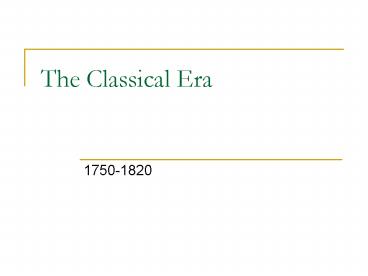The Classical Era - PowerPoint PPT Presentation
1 / 18
Title:
The Classical Era
Description:
The Classical Era 1750-1820 Classicism Classicism, in the arts, refers generally to a high regard for classical antiquity (arts, architecture, etc.), as setting ... – PowerPoint PPT presentation
Number of Views:239
Avg rating:3.0/5.0
Title: The Classical Era
1
The Classical Era
- 1750-1820
2
Classicism
- Classicism, in the arts, refers generally to a
high regard for classical antiquity (arts,
architecture, etc.), as setting standards for
taste which the classicist seeks to emulate. The
art of classicism typically seeks to be formal
and restrained en.Wikipedia.org
3
Classical origins - Architecture
- From the point of view of modern times, the
ancient civilizations of the Mediterranean
sometimes seem to blend smoothly into one mix we
call the Classical. - Further divided, the period includes
- Greek architecture
- Hellenistic architecture
- Roman architecture
4
Greek Classicism
5
(No Transcript)
6
Classical influence
- The clean and simple style of the ancient
classical period appealed to people who were
looking for new ideas and direction - Artists (architects, composers, painters, etc.)
began to mimic the clean lines and style of
ancient classicism
7
Schonbrunn Palace, Vienna
8
9
Belvedere Palace, Vienna
10
(No Transcript)
11
(No Transcript)
12
Socio-Economic Structure
- The aristocracy (ruled by the best) is the
dominant force of the time and are the primary
patrons of the arts. - Music is driven by this patronage composers are
hired by royalty to work in-house (court
composer), emperors employ composers, and music
is written to please these patrons, who desire
impersonal but tuneful and elegant music - Class division intensifies
13
Socio-economic cont
- Sacred (religious) music still exists, but is
supplanted by secular (non-religious) music as
the primary outlet for composers - Public concerts grow in popularity
14
Homophony
- Dominant melody with accompanying voices
- Much simpler and cleaner than polyphony
15
Musical Changes
- Music was written for specific ensembles and
instruments - Musical elements were much more clearly defined
- Form became much more clearly defined Sonata,
Concerto - Technological developments clarinet, brass (but
no valves, yet)
16
(No Transcript)
17
Sonata Form
- The most popular form of the classical era
- Introduction optional
- Exposition Subject (in home key), transition
(to a new key), Subject II (in a different key
usually the dominant), Codetta - Development Thematic and harmonic development
takes place, then retransitions to the main key - Recapitulation Restatement of all original
subjects, now all in the home key - Coda
18
Vienna
- Musically, the centre of the universe in the 17th
century - Haydn, Mozart and Beethoven all lived most of
their musical lives in this city - Beethoven is buried here































